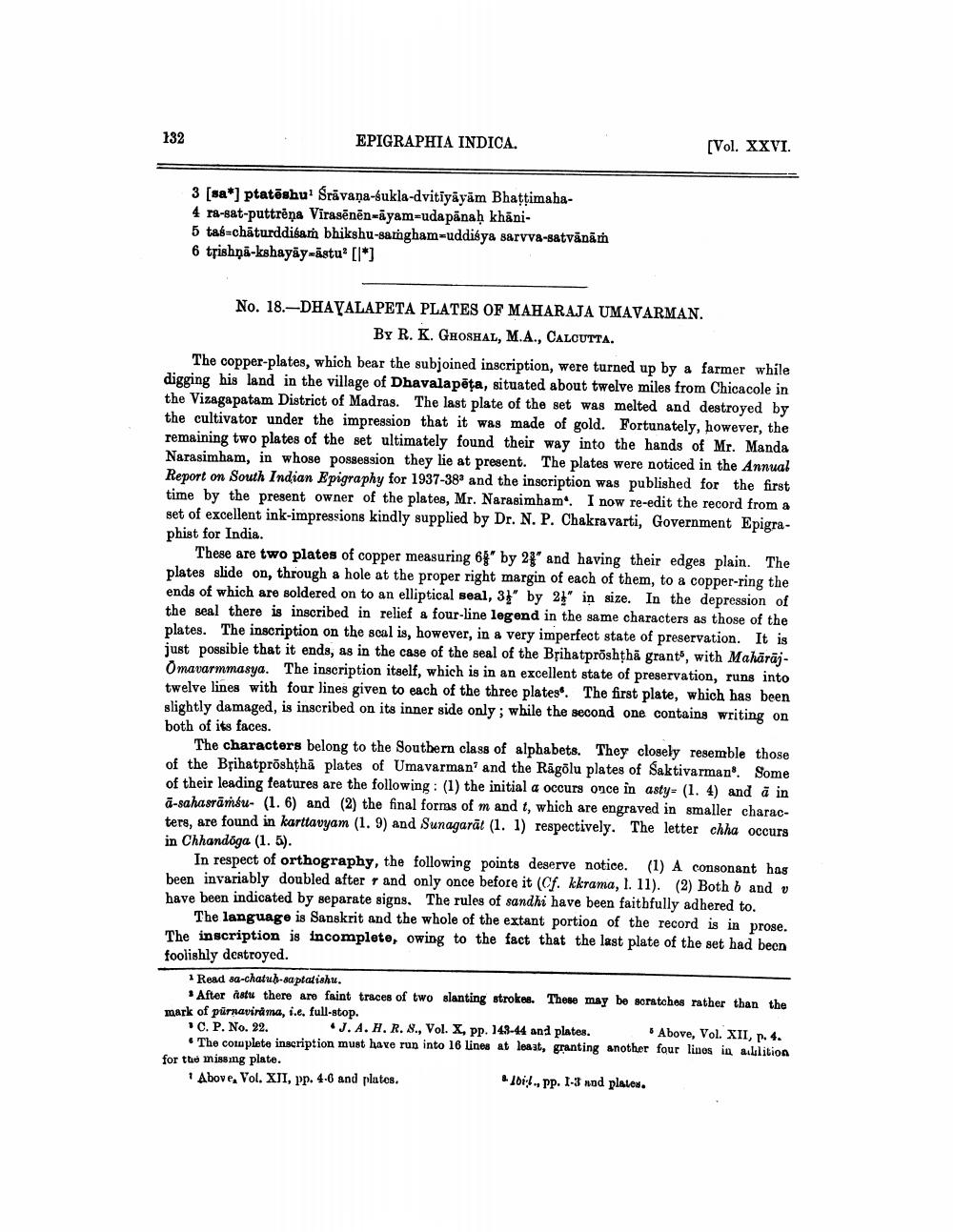________________
132
EPIGRAPHIA INDICA.
[Vol. XXVI.
3 [sa*) ptatēshu: Srāvana-sukla-dvitiyāyām Bhattimaha4 ra-bat-puttrėna Virasēnēn-ayam-udapānaḥ khāni5 tas-chāturddisam bhikshu-samgham-uddiśya sarvva-satvānām 6 trishņā-kshayāy=āstu[l*]
No. 18.-DHAVALAPETA PLATES OF MAHARAJA UMAVARMAN.
BY R. K. GHOSHAL, M.A., CALCUTTA. The copper-plates, which bear the subjoined inscription, were turned up by a farmer while digging his land in the village of Dhavalapēta, situated about twelve miles from Chicacole in the Vizagapatam District of Madras. The last plate of the set was melted and destroyed by the cultivator under the impression that it was made of gold. Fortunately, however, the remaining two plates of the set ultimately found their way into the hands of Mr. Manda Narasimham, in whose possession they lie at present. The plates were noticed in the Annual Report on South Indian Epigraphy for 1937-388 and the inscription was published for the first time by the present owner of the plates, Mr. Narasimham. I now re-edit the record from a set of excellent ink-impressions kindly supplied by Dr. N. P. Chakravarti, Government Epigraphist for India
These are two plates of copper measuring 65" by 23" and having their edges plain. The plates slide on, through a hole at the proper right margin of each of them, to a copper-ring the ends of which are soldered on to an elliptical seal, 31' by 21" in size. In the depression of the seal there is inscribed in relief a four-line legend in the same characters as those of the plates. The inscription on the scal is, however, in a very imperfect state of preservation. It is just possible that it ends, as in the case of the seal of the Bțihatproshthā grant', with MahārājOmavarmmasya. The inscription itself, which is in an excellent state of preservation, runs into twelve lines with four lines given to each of the three platese. The first plate, which has been slightly damaged, is inscribed on its inner side only; while the second one contains writing on both of its faces.
The characters belong to the Southern class of alphabets. They closely resemble those of the Brihatpröshthā plates of Umavarman and the Rägolu plates of Saktivarmano. Some of their leading features are the following: (1) the initial a occurs once in asty- (1. 4) and a in ā-sahasrāṁsu- (1.6) and (2) the final forms of m and t, which are engraved in smaller characters, are found in karttavyam (1.9) and Sunagarāt (1. 1) respectively. The letter chha occurs in Chhandoga (1. 5).
In respect of orthography, the following points deserve notice. (1) A consonant has been invariably doubled after and only once before it (Cf. kkrama, I. 11). (2) Both b and v have been indicated by separate signs. The rules of sandhi have been faitbfully adhered to.
The language is Sanskrit and the whole of the extant portion of the record is in prose. The inscription is incomplete, owing to the fact that the last plate of the set had been foolishly destroyed.
1 Read 8a-chatuh-saptatishu.
After Astu there are faint traces of two slanting strokes. These may be soratohes rather than the mark of pürnavirama, i.e. full-stop. C. P. No. 22. J. A. H. R. 8., Vol. X, pp. 143-44 ans plates.
Above, Vol. XII, p. 4. • The complete inscription must have run into 16 lines at least, granting another four lives in allition for the missing plate. Above, Vol. XII, pp. 4-6 and plates.
Ibid., pp. 1-3 nod plates.




